Related Research Articles

In baseball, hit by pitch (HBP) is an event in which a batter or his clothing or equipment is struck directly by a pitch from the pitcher; the batter is called a hit batsman (HB). A hit batsman is awarded first base, provided that he made an honest effort to avoid the pitch, although failure to do so is rarely called by an umpire. Being hit by a pitch is often caused by a batter standing too close to, or "crowding", home plate.
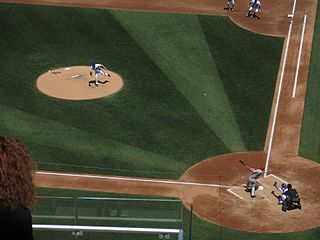
Baseball is a bat-and-ball sport played between two teams of nine players each, taking turns batting and fielding. The game occurs over the course of several plays, with each play generally beginning when a player on the fielding team, called the pitcher, throws a ball that a player on the batting team, called the batter, tries to hit with a bat. The objective of the offensive team is to hit the ball into the field of play, away from the other team's players, allowing its players to run the bases, having them advance counter-clockwise around four bases to score what are called "runs". The objective of the defensive team is to prevent batters from becoming runners, and to prevent runners' advance around the bases. A run is scored when a runner legally advances around the bases in order and touches home plate.
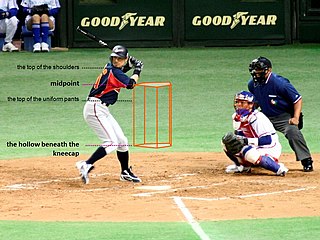
In baseball, the strike zone is the volume of space through which a pitch must pass in order to be called a strike even if the batter does not swing. The strike zone is defined as the volume of space above home plate and between the batter's knees and the midpoint of their torso. Whether a pitch passes through the zone is decided by an umpire, who is generally positioned behind the catcher.

Softball is a game similar to baseball, and it is played with a larger ball on a smaller field and with only underhand pitches permitted. Softball is played competitively at club levels, the college level, and the professional level. The game was first created in 1887 in Chicago by George Hancock.

In baseball, the pitcher is the player who throws ("pitches") the baseball from the pitcher's mound toward the catcher to begin each play, with the goal of retiring a batter, who attempts to either make contact with the pitched ball or draw a walk. In the numbering system used to record defensive plays, the pitcher is assigned the number 1. The pitcher is often considered the most important player on the defensive side of the game, and as such is situated at the right end of the defensive spectrum. There are many different types of pitchers, such as the starting pitcher, relief pitcher, middle reliever, lefty specialist, setup man, and the closer.

The fastball is the most common type of pitch thrown by pitchers in baseball and softball. "Power pitchers," such as former American major leaguers Nolan Ryan and Roger Clemens, rely on speed to prevent the ball from being hit and throw fastballs at speeds of 95–105 miles per hour (153–169 km/h) (officially) and up to 108.1 miles per hour (174.0 km/h) (unofficially). Pitchers who throw more slowly can put movement on the ball, or throw it on the outside of home plate where batters cannot easily reach it.

A changeup is a type of pitch in baseball and fastpitch softball.

A four-seam fastball, also called a rising fastball, a four-seamer, or a cross-seam fastball, is a pitch in baseball. It is a member of the fastball family of pitches and is usually the hardest ball thrown by a pitcher. It is called what it is because with every rotation of the ball as it is thrown, four seams come into view. A few pitchers at the major league level can sometimes reach a pitch speed of over 100 mph. It is often compared with the two-seam fastball.
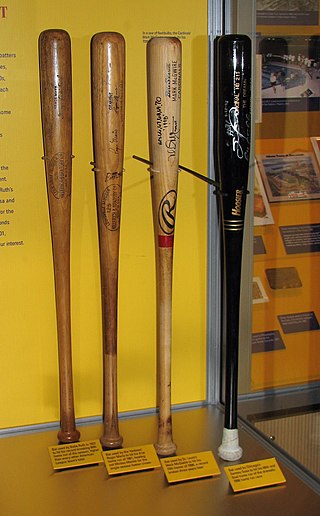
A baseball bat is a smooth wooden or metal club used in the sport of baseball to hit the ball after it is thrown by the pitcher. By regulation it may be no more than 2.75 inches (7.0 cm) in diameter at the thickest part and no more than 42 inches (1.067 m) in length. Although historically bats approaching 3 pounds (1.4 kg) were swung, today bats of 33 ounces (0.94 kg) are common, topping out at 34 to 36 ounces.

Throughout the history of baseball, the rules have frequently changed as the game continues to evolve. A few common rules most professional leagues have in common is that four balls is a base on balls, three strikes is a strikeout, and three outs end a half-inning.
Baseball and cricket are the best-known members of a family of related bat-and-ball games. Both have fields that are 400 feet (120 m) or more in diameter between their furthest endpoints, offensive players who can hit a thrown/"bowled" ball out of the field and run between safe areas to score runs (points) at the risk of being gotten out, and have a major game format lasting about 3 hours.

In baseball, batting is the act of facing the opposing pitcher and trying to produce offense for one's team. A batter or hitter is a person whose turn it is to face the pitcher. The three main goals of batters are to become a baserunner, to drive runners home or to advance runners along the bases for others to drive home, but the techniques and strategies they use to do so vary. Hitting uses a motion that is virtually unique to baseball and its fellow bat-and-ball sports, one that is rarely used in other sports. Hitting is unique because it involves rotating in the horizontal plane of movement, unlike most sports movements which occur in the vertical plane.

Baseball Mogul is a series of career baseball management computer games created by game designer Clay Dreslough. The product was first published in 1997. The 26th and latest installment is Baseball Mogul 2023. A proprietary database, included with the game, permits play in any season of historical baseball from 1901 to the present. The early Baseball Mogul games are considered to be influential works within the baseball management simulation genre.

Major League Baseball Featuring Ken Griffey Jr. is a baseball video game developed by Angel Studios and published by Nintendo for the Nintendo 64. The game is a follow-up to Nintendo's previous title featuring Griffey, Ken Griffey Jr.'s Winning Run. It was released in 1998, and allows players to choose any contemporary Major League Baseball franchise and play through an exhibition, a complete season, or a World Series. Players can also select up to four individuals from any team to compete in a Home Run Derby. The game also features all 30 MLB teams' stadiums. The game was seen as a faster, more arcade-like baseball game compared to its rivaling product, the more realistic baseball simulation All-Star Baseball '99. Nintendo released a sequel the following year, called Ken Griffey Jr.'s Slugfest.
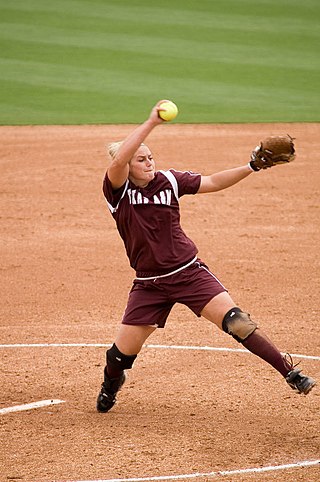
Fastpitch softball, or simply fastpitch, is a form of softball played by both women and men. While the teams are most often segregated by sex, coed fast-pitch leagues also exist. Considered the most competitive form of softball, fastpitch is the format played at the Olympic Games. Softball was on the International Olympic Committee (IOC) program in 1996, 2000, 2004, 2008, and 2020. It will not be a part of the 2024 Summer Olympic Games in Paris.
This is an alphabetical list of selected unofficial and specialized terms, phrases, and other jargon used in baseball, along with their definitions, including illustrative examples for many entries.
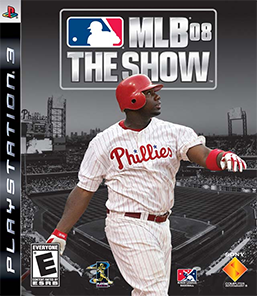
MLB 08: The Show is a baseball simulation video game developed by San Diego Studio published by Sony Computer Entertainment for the PlayStation 2, PlayStation 3, and PlayStation Portable systems. It is the longest-running officially licensed Major League Baseball game series on the PlayStation systems. MLB 08: The Show is the third edition of the MLB: The Show series of video games. The game was announced for all three PlayStation consoles on December 11, 2007, and released on March 4, 2008 in North America. Ryan Howard, all-star first baseman for the Philadelphia Phillies, is featured as the game's cover athlete.
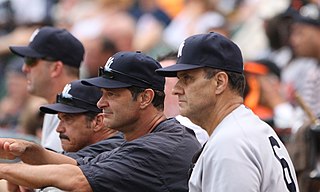
In baseball, a number of coaches assist in the smooth functioning of a team. They are assistants to the manager, who determines the starting lineup and batting order, decides how to substitute players during the game, and makes strategy decisions. Beyond the manager, more than a half dozen coaches may assist the manager in running the team. Essentially, baseball coaches are analogous to assistant coaches in other sports, as the baseball manager is to the head coach.
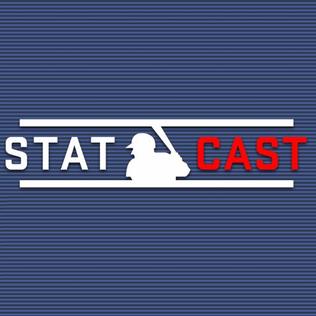
Statcast is a high-speed, high-accuracy, automated tool developed to analyze player movements and athletic abilities in Major League Baseball (MLB).
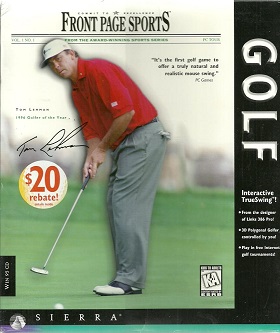
Front Page Sports: Golf is a golf simulation video game developed by Headgate Studios and published by Sierra On-Line for Microsoft Windows. The game was released in 1997, after nearly three years of development. It was particularly praised for its TrueSwing method, in which the player uses the computer mouse to simulate the golf swing.
References
- ↑ "Front Page Sports Baseball '94". Next Generation . Imagine Media (4): 91. April 1995.
- 1 2 Kaiafas, Tasos (July 1996). "Front Page Sports: Baseball Pro '96". Computer Game Review . Archived from the original on December 21, 1996.
- ↑ Poole, Stephen (July 3, 1997). "Front Page Sports: Baseball Pro '98 Review". GameSpot . Retrieved 7 July 2016.